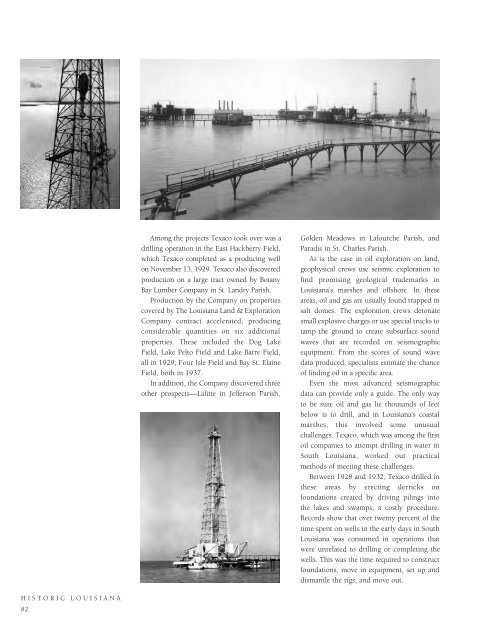Historic Louisiana
An illustrated history of Louisiana, paired with the histories of companies, families and organizations that make the state great.
An illustrated history of Louisiana, paired with the histories of companies, families and organizations that make the state great.
You also want an ePaper? Increase the reach of your titles
YUMPU automatically turns print PDFs into web optimized ePapers that Google loves.
Among the projects Texaco took over was a<br />
drilling operation in the East Hackberry Field,<br />
which Texaco completed as a producing well<br />
on November 13, 1929. Texaco also discovered<br />
production on a large tract owned by Botany<br />
Bay Lumber Company in St. Landry Parish.<br />
Production by the Company on properties<br />
covered by The <strong>Louisiana</strong> Land & Exploration<br />
Company contract accelerated, producing<br />
considerable quantities on six additional<br />
properties. These included the Dog Lake<br />
Field, Lake Pelto Field and Lake Barre Field,<br />
all in 1929; Four Isle Field and Bay St. Elaine<br />
Field, both in 1937.<br />
In addition, the Company discovered three<br />
other prospects—Lafitte in Jefferson Parish,<br />
Golden Meadows in Lafourche Parish, and<br />
Paradis in St. Charles Parish.<br />
As is the case in oil exploration on land,<br />
geophysical crews use seismic exploration to<br />
find promising geological trademarks in<br />
<strong>Louisiana</strong>’s marshes and offshore. In these<br />
areas, oil and gas are usually found trapped in<br />
salt domes. The exploration crews detonate<br />
small explosive charges or use special trucks to<br />
tamp the ground to create subsurface sound<br />
waves that are recorded on seismographic<br />
equipment. From the scores of sound wave<br />
data produced, specialists estimate the chance<br />
of finding oil in a specific area.<br />
Even the most advanced seismographic<br />
data can provide only a guide. The only way<br />
to be sure oil and gas lie thousands of feet<br />
below is to drill, and in <strong>Louisiana</strong>’s coastal<br />
marshes, this involved some unusual<br />
challenges. Texaco, which was among the first<br />
oil companies to attempt drilling in water in<br />
South <strong>Louisiana</strong>, worked out practical<br />
methods of meeting these challenges.<br />
Between 1928 and 1932, Texaco drilled in<br />
these areas by erecting derricks on<br />
foundations created by driving pilings into<br />
the lakes and swamps, a costly procedure.<br />
Records show that over twenty percent of the<br />
time spent on wells in the early days in South<br />
<strong>Louisiana</strong> was consumed in operations that<br />
were unrelated to drilling or completing the<br />
wells. This was the time required to construct<br />
foundations, move in equipment, set up and<br />
dismantle the rigs, and move out.<br />
HISTORIC LOUISIANA<br />
82
















